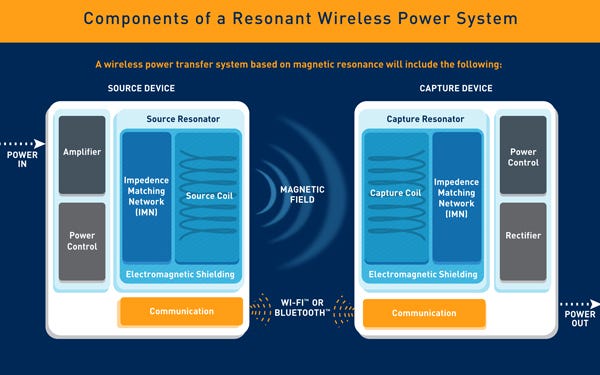Greatbatch Is Betting Big on Wireless Energy Charging
May 4, 2016
The medical device manufacturing outsourcer has greatly expanded its business relationship with WiTricity, which has wireless energy transfer technology.
Chris Newmarker
|
(Infograph courtesy of WiTricity) |
Greatbatch appears to be wagering that wireless energy transfer technology will prove to be an attractive feature in many medical devices, including implantables.
Frisco, TX-based Greatbatch has licensed intellectual property from Watertown, MA-based WiTricity in order to incorporate efficient, high-performance wireless charging and power systems in wide range of medical devices, including interventional applications and active implantables, the two companies said Wednesday.
The deal expands on a previously relationship, announced August 2015, to use WiTricity's technology in surgical and portable medical equipment.
"Medical devices and systems are primed for a revolution, and wireless power transfer will allow designers to develop smaller, safer, easier to use, and more reliable solutions for physicians and patients," said Declan Smyth, president of advanced surgical, orthopedics, and power solutions at Greatbatch.
Greatbatch has not yet disclosed specific product plans.
Founded with MIT-based technology, WiTricity's wireless resonant energy transfer systems are based on finely tuned oscillating magnetic fields between coils at a distance. The company is touting unique benefits for the technology when it comes to medtech, including high efficiency charging with flexible positioning and increased distance. Charging can also take place through non-metallic materials including plastic and glass, and the technology could improve the usability and efficiency of implantable devices charged or powered through the skin.
WiTricity has also worked with Thoratec, now part of St. Jude Medical, on a system that can transfer 10 watts of power into a human body to power an LVAD--a system that in the future should hopefully do away with the need for LVAD patients to have a wire running through their skin
"Implantable medical applications are a natural fit for WiTricity technology, allowing new designs that increase patient comfort, allow for reduced battery sizes and deliver a better overall patient experience," said WiTricity CEO Alex Gruzen.
Learn more about cutting-edge medical devices at MD&M East, June 14-15, 2016 in New York City. |
Chris Newmarker is senior editor of Qmed and MPMN. Follow him on Twitter at @newmarker.
Like what you're reading? Subscribe to our daily e-newsletter.
About the Author(s)
You May Also Like


.png?width=300&auto=webp&quality=80&disable=upscale)
